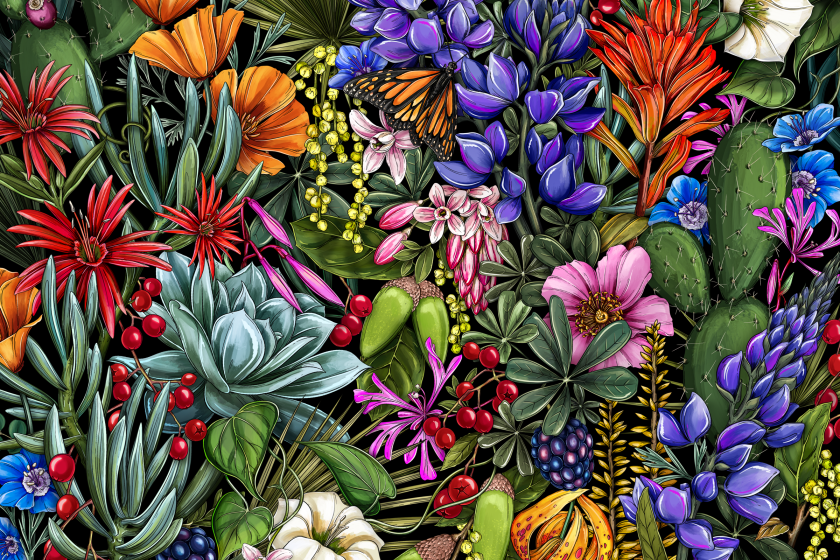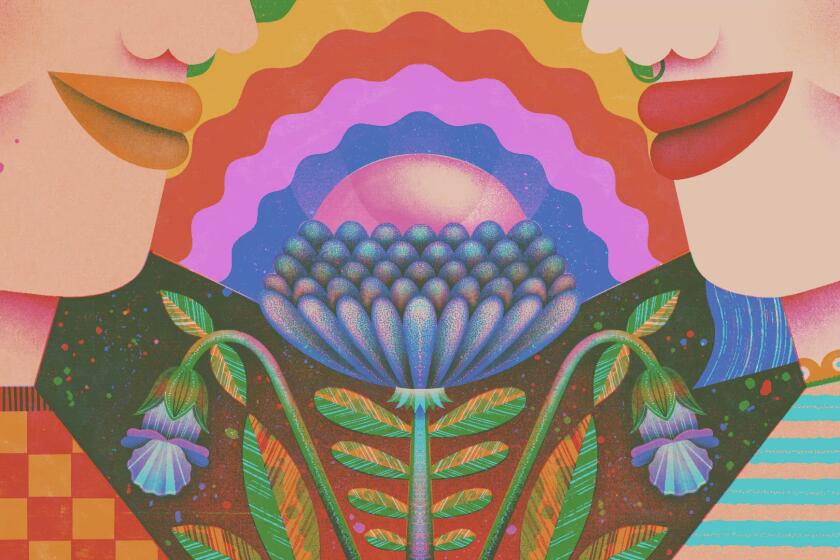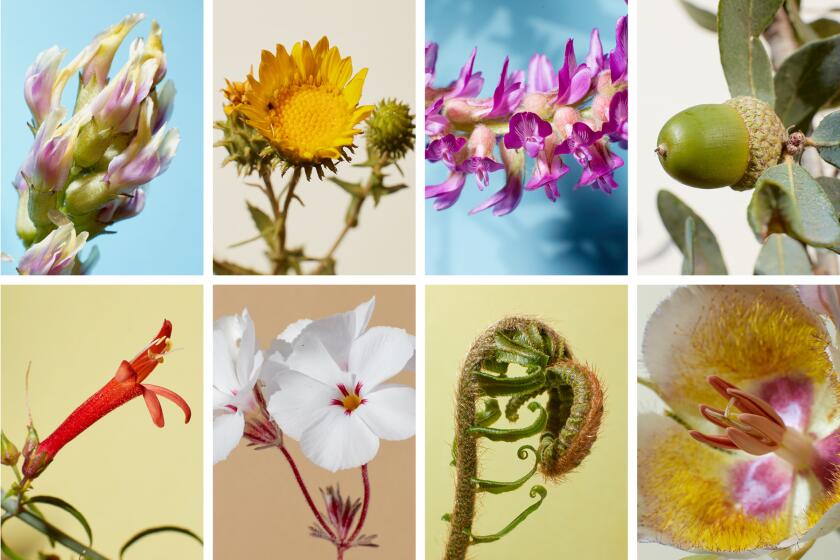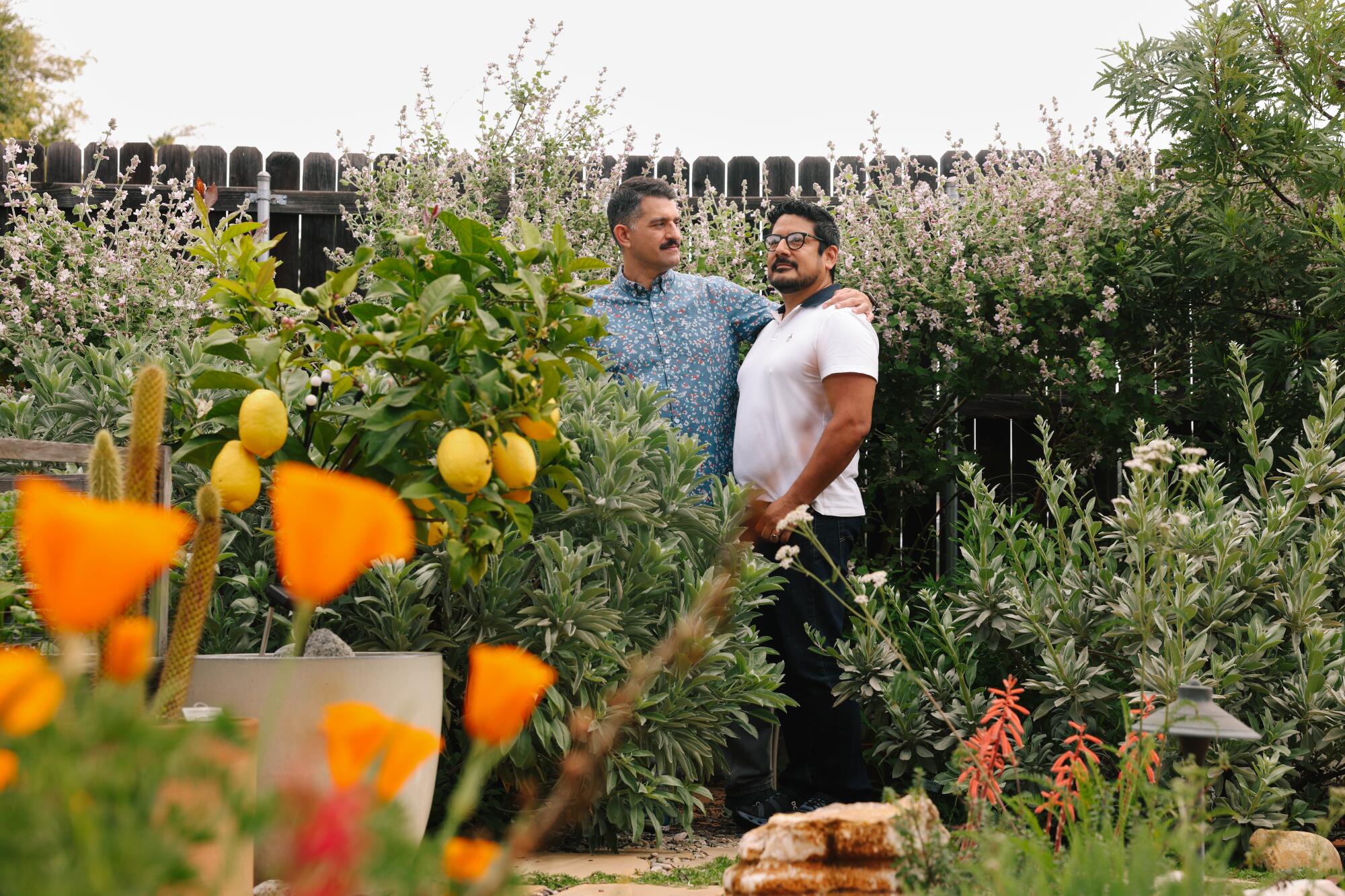
Water-hungry lawns are symbols of Los Angeles’ past. In this series, we spotlight yards with alternative, low-water landscaping built for the future.
At the top of a roller-coaster hill in Highland Park, Thomas Zamora and his husband, Raul Rojas, enjoy two spectacular views — of the Pasadena hills to the east and of the meandering expanse of native plants, succulents and vegetables in a backyard that once was nothing but dirt and junk cars.
It’s been an evolution of nearly a decade, say Zamora and Rojas, but today, their backyard boasts a deck rimmed with pots of colorful succulents and wide water-permeable paths of flagstone and river pebbles, lined with fragrant plantings of California native trees and flowering shrubs. There’s a raised bed full of vegetables, a potted lemon tree and a few red-blooming Australian grevilleas and South African leucadendron left over from the early days of their landscaping journey “because the hummingbirds love them so much,” Zamora said. “They fight over the flowers, so we couldn’t stand to take them out.”
But almost everything else in the backyard, along with the terraced planters out front and the parkway, is devoted to California native plants, a passion inspired by the Theodore Payne Foundation’s Native Plant Garden Tour in 2015, when the couple saw what beautiful gardens others had created from native perennials, shrubs and wildflowers.
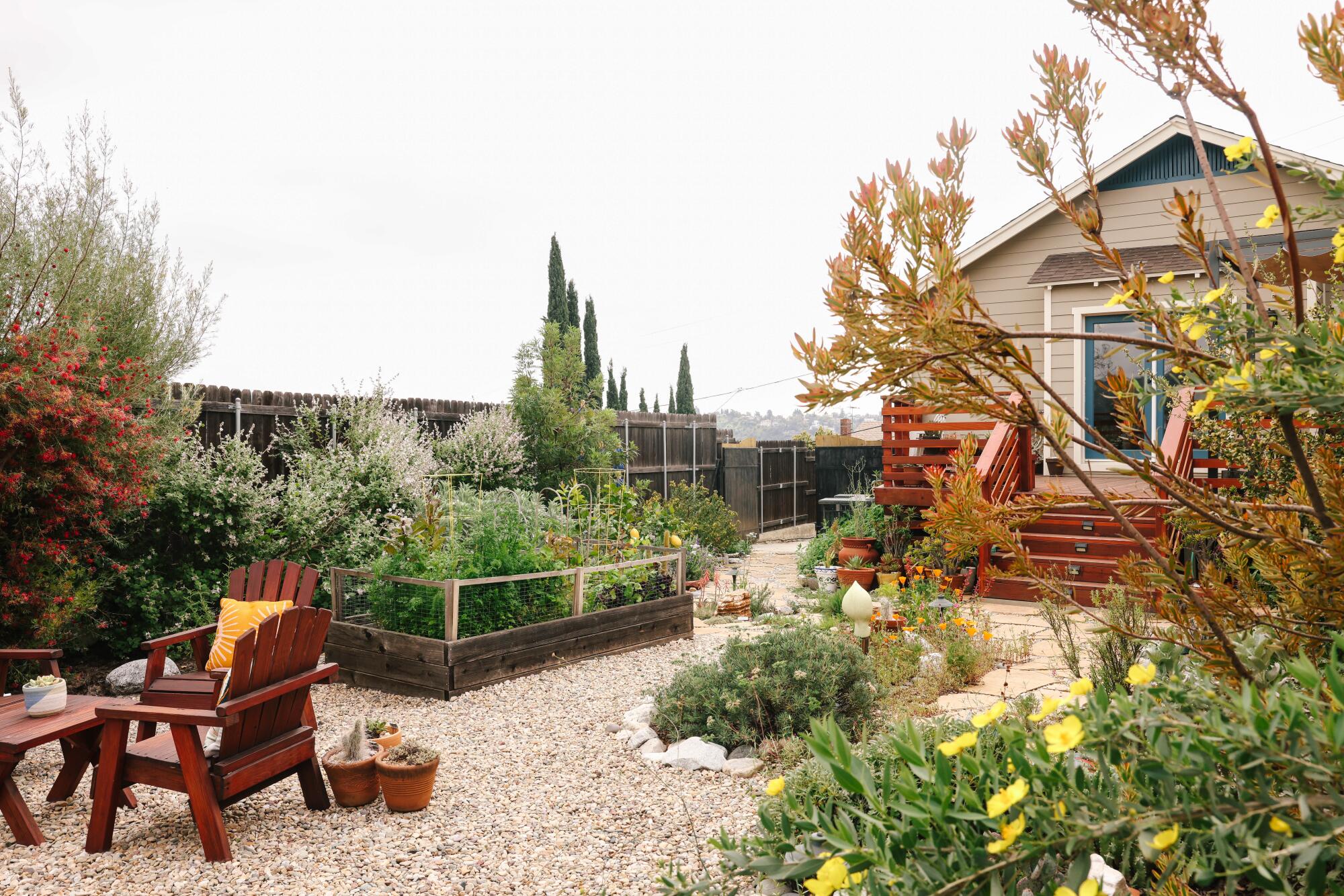
“That started us on our journey of ‘Frankensteining’ our landscape,” Zamora said, laughing. “The tours helped us get ideas for what elements we thought would look great in our yard. It wasn’t a formal process, because we did things ourselves. We found things we wanted, and places to fit them in, and just sort of winged it.”
They winged it so well that their home is now a regular part of Theodore Payne’s Native Plant Garden Tour, being held on April 13 and 14 this year. (Tickets are sold out online, but at publication time were still available for purchase in person at the foundation’s office in Sun Valley, Tuesdays through Saturdays from 8:30 a.m. to 4:30 p.m. for $55 (children under 16 are free).
Here are the best retail native plant nurseries in Southern California to help you create a habitat for birds and pollinators in your yard or even on a patio.
The couple’s garden is alive with bees, hummingbirds and other pollinators, and there are chairs and even a flower-shaded bench for visitors to sit and admire the view. The space exudes serenity and invites wanderers —and is clearly a labor of love for both Zamora and Rojas. “Every Sunday is garden day and we enjoy the process,” Rojas said. “It’s a place for exercise and meditation ... our happy place. And who does the weeding? Us!”
On their tidy potting bench, a butter knife rests in a pot, at the ready to tackle any unwanted sprouts. “The best weeding tool is a butter knife,” Rojas says confidentially. “My grandma taught me that; you just jab the knife in at the base of the root and pull the weed up by pinching it between two fingers.”
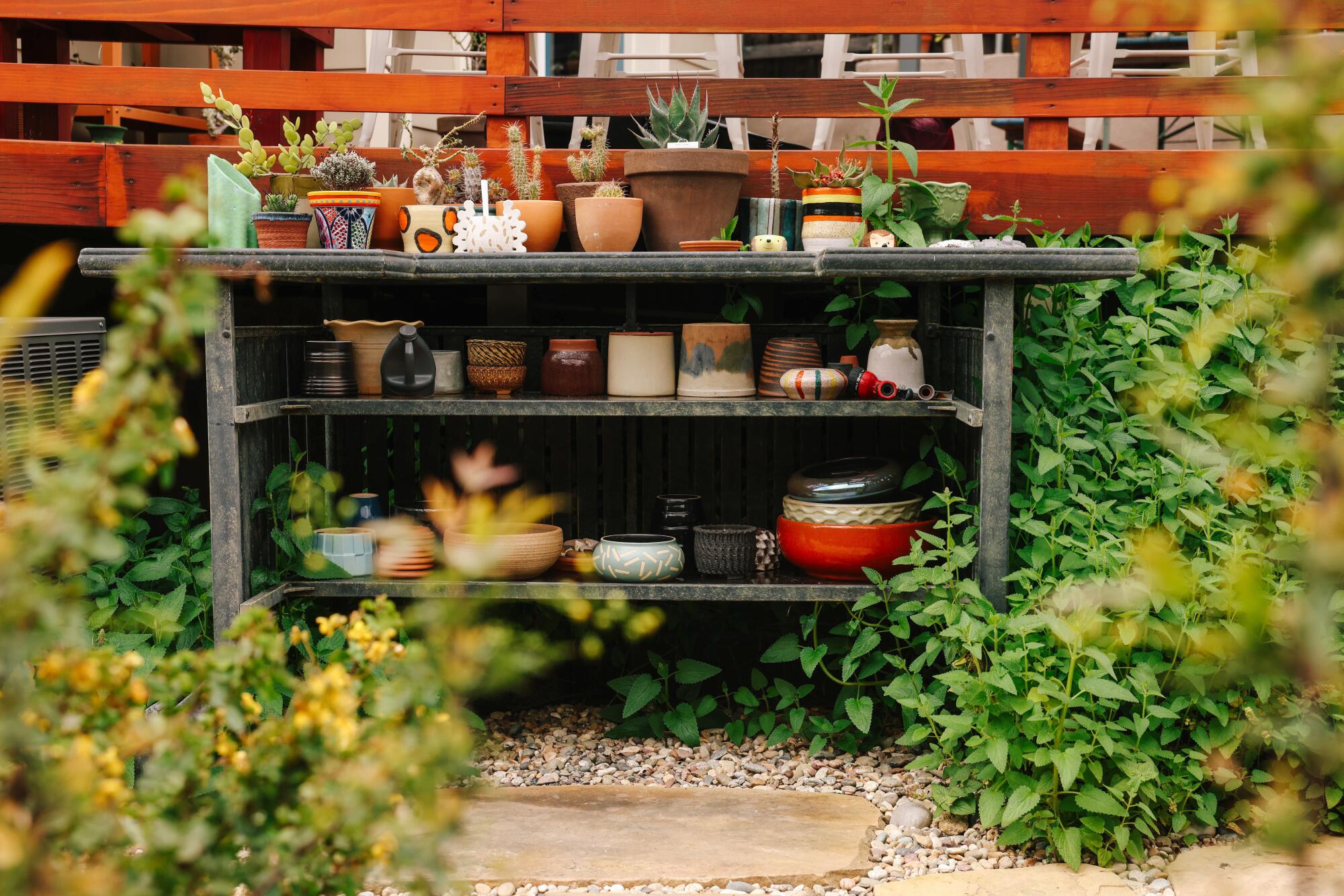
Clearly the technique works, because weeds — the bane of most gardens, including native plant landscapes — are visible nowhere in this yard. The plantings are jumbled but meticulous — almost Disney-esque — with brimming pots of succulents on the front porch and overflowing terraces of blue-blooming rosemary, a Mediterranean plant, along with native plants like evergreen currant (Ribes viburnifolium), island alum root (Heuchera maxima), fragrant blue pitcher sage (Lepechinia fragrans), bush sunflowers (Encelia californica) and island buckwheat hybrid (Eriogonum x blissianum)
It all looks perfect, down to the beautiful tangle of poppies and other native wildflowers in the narrow strip of parkway. But the process offered plenty of challenges, Zamora and Rojas said. “We’ve learned a lot along the way,” Rojas said.
California native plants have many pros, but their potent scents are the biggest draw of all. Gardening experts share the most fragrant native plants.
Both men are California natives whose families enjoyed gardening and being outdoors, but they grew up around more traditional plants like roses, fruit trees and succulents. Plus, Rojas laughed, his parents kept him busy pulling weeds as a child.
When Zamora, an art department coordinator for TV shows like “No Good Deed,” bought the 1923 bungalow in 2009, the smallish backyard was filled with hard dirt and three junk cars, which thankfully were removed before he moved in in 2010. In the beginning, before he met Rojas, he focused more on the interior of the house and dabbled at planting just a few flower beds outside. He said his focus then was on showy drought-tolerant plants like statice and Pride of Madeira, a fast-growing perennial with giant purple blooms native to the Portuguese island of Madeira.
1
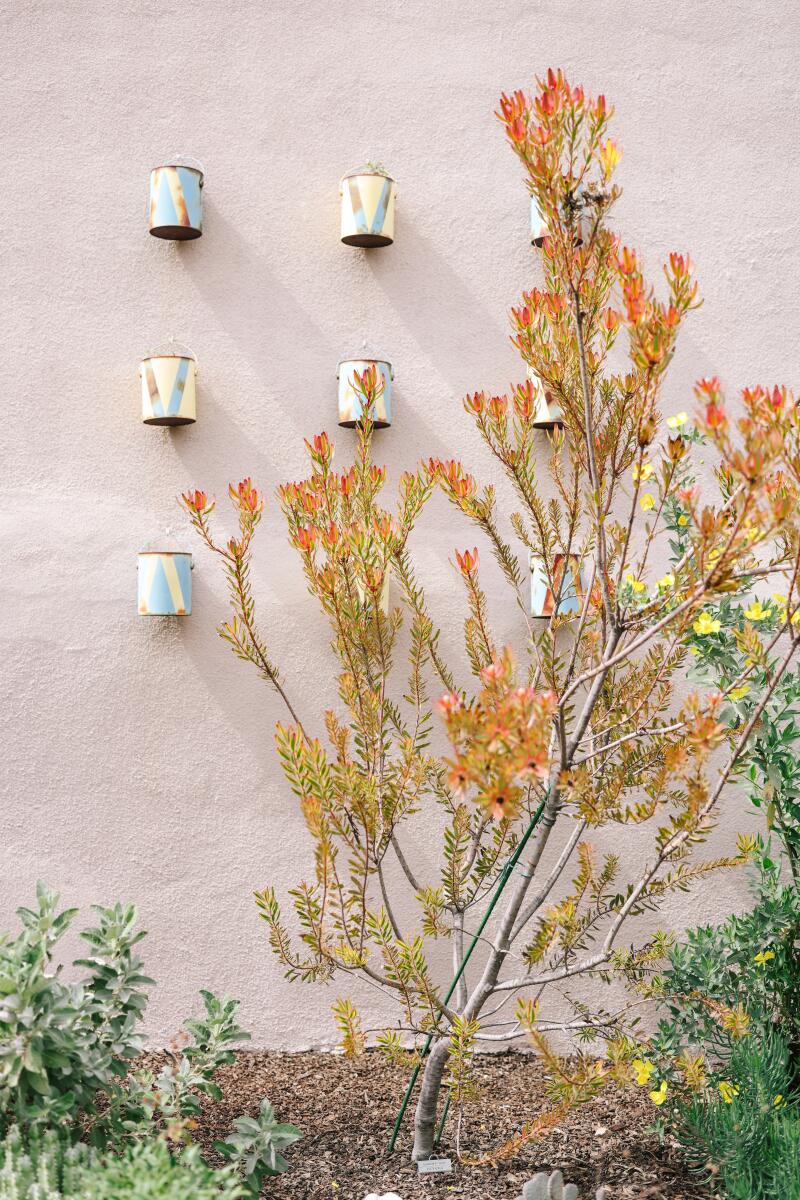
2
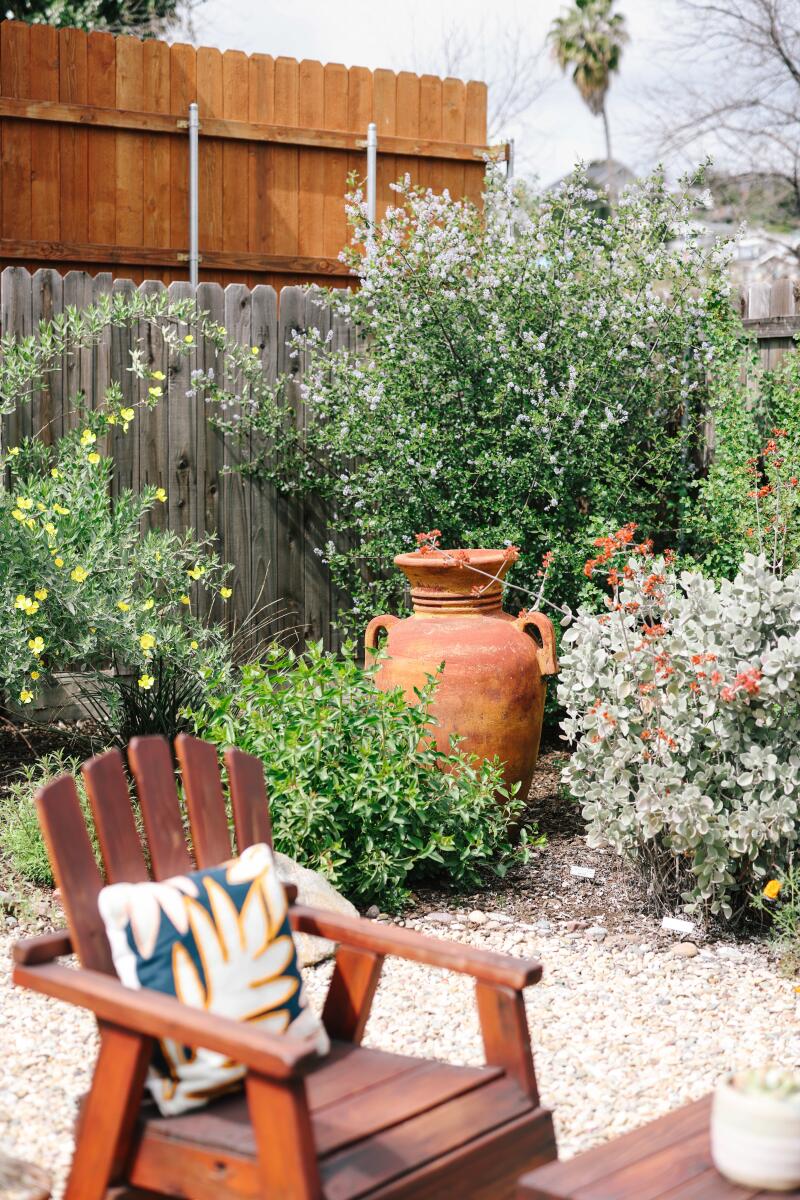
1. A leucadendron “Jester” from South Africa grows against a neighbor’s garage wall, against an artistic display of paint cans. The leucadendron is a holdover from Zamora’s earliest landscaping attempts, kept because it’s so popular with the hummingbirds. 2. (Dania Maxwell/Los Angeles Times)
“I didn’t realize these plants are invasive along the central coast,” he said. “I was just planting things because they looked pretty, and I knew they would grow because I’d seen them in other places.”
He added the leucadendron and grevillea for their showstopping, drought-tolerant blooms. But he also planted a white sage (Salvia apiana) because he admired the silvery green foliage of one of Southern California’s most famous indigenous plants during a local hike.
After Rojas moved in in 2012, the couple got more serious about the yard, visiting plant stores and nurseries to get ideas. In 2015, during a visit to Potted in Atwater Village, they saw a flier for the Theodore Payne tour and decided to give it try. It was easy to buy tickets for the tour in those days, Rojas said — “They didn’t sell out like they do today” — and the gardens they saw finally gave their landscaping a sharp focus: native plants.
“It was one of the best decisions we ever made,” Zamora said.
But once they started adding native plants in earnest, the challenges started. They amended their heavy clay soil with compost and other additives, something you would normally do to plant traditional landscape ornamentals and food. But after many of the new plants died, they learned their yard had mostly heavy, slow-draining clay soil, and that native plants prefer well-draining native soils over enriched garden plots.
At 34, Matt Smith is a widower and amateur botanist whose grief and passion are fueling a quest some might call quixotic — to photograph every plant native to Los Angeles County.
“I learned that from one of Theodore Payne’s ‘Right Plant, Right Place’ classes that teaches you what plants do best in your situation,” Zamora said. “And I also used Calscape to find out if the plants I’m interested in will tolerate clay soils. That’s how we figured out a plan for adding plants we would love to have but don’t have a place where they will work.”
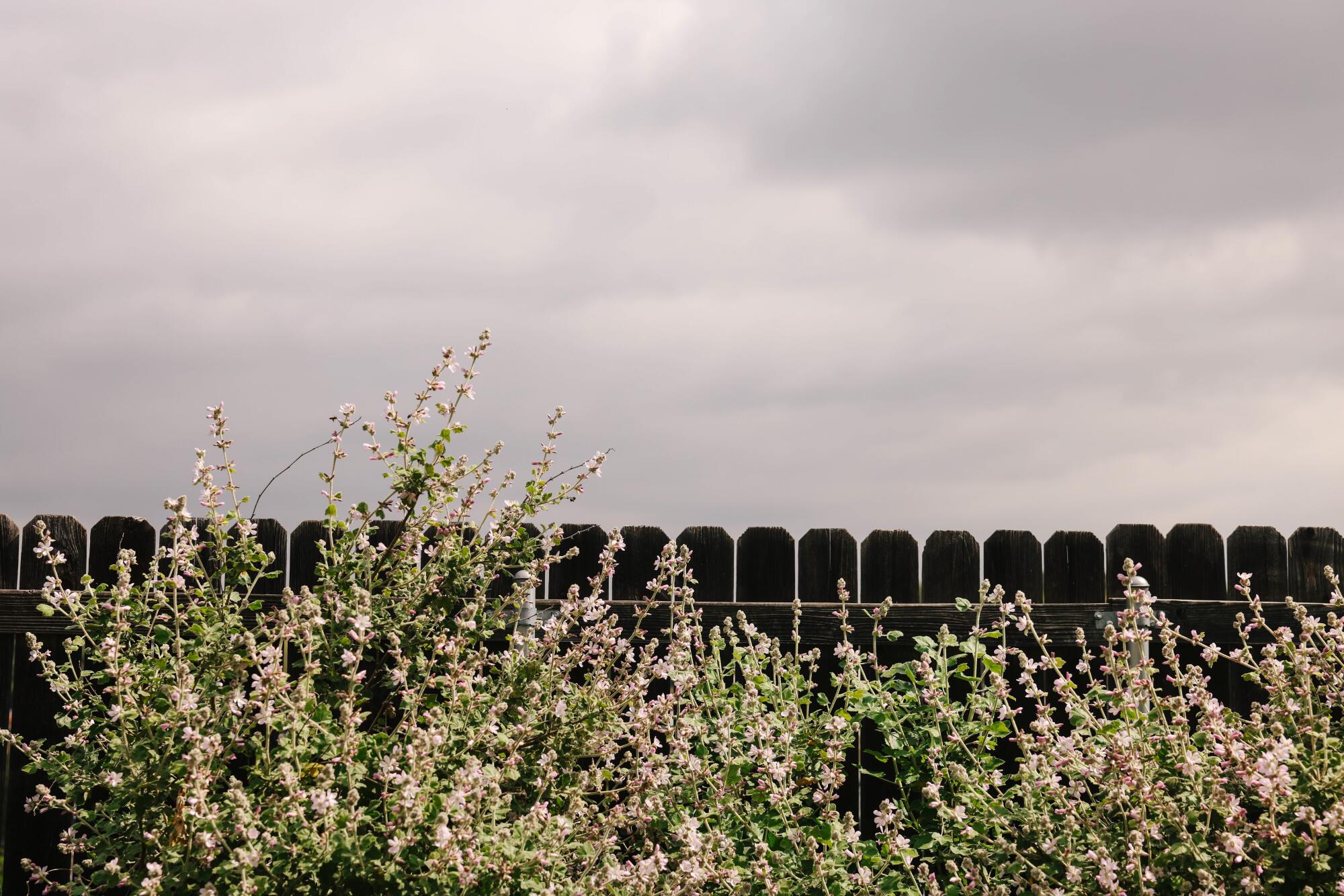
They grow plants that don’t like clay in pots, such as the super-sweet smelling woolly bluecurls (Trichostema lanatum) near their side door; once established, it’s easily killed by too much water. The white sage has thrived, along with a very happy San Clemente Island bushmallow (Malacothamnus clementinus) that has grown from a one-gallon container to a massive shrub covered with blooms along their east fence.
They never really had a formal design, Zamora said. They tried things, and if it didn’t work, they tried something else. Initially they added two raised beds for vegetables but eventually removed one to create more space for paths and native plantings.
Adding pebble walkways helped solve problems with runoff and standing water in the backyard. “We do not have a bioswale [to capture rainwater until it drains into the soil] — I wish I had known about those when I was doing the walks,” Zamora said. “But I leveled the area so the water doesn’t pool now, and the rocks seem to help hold water so it doesn’t run off; it just seeps into the ground through the pavers.”
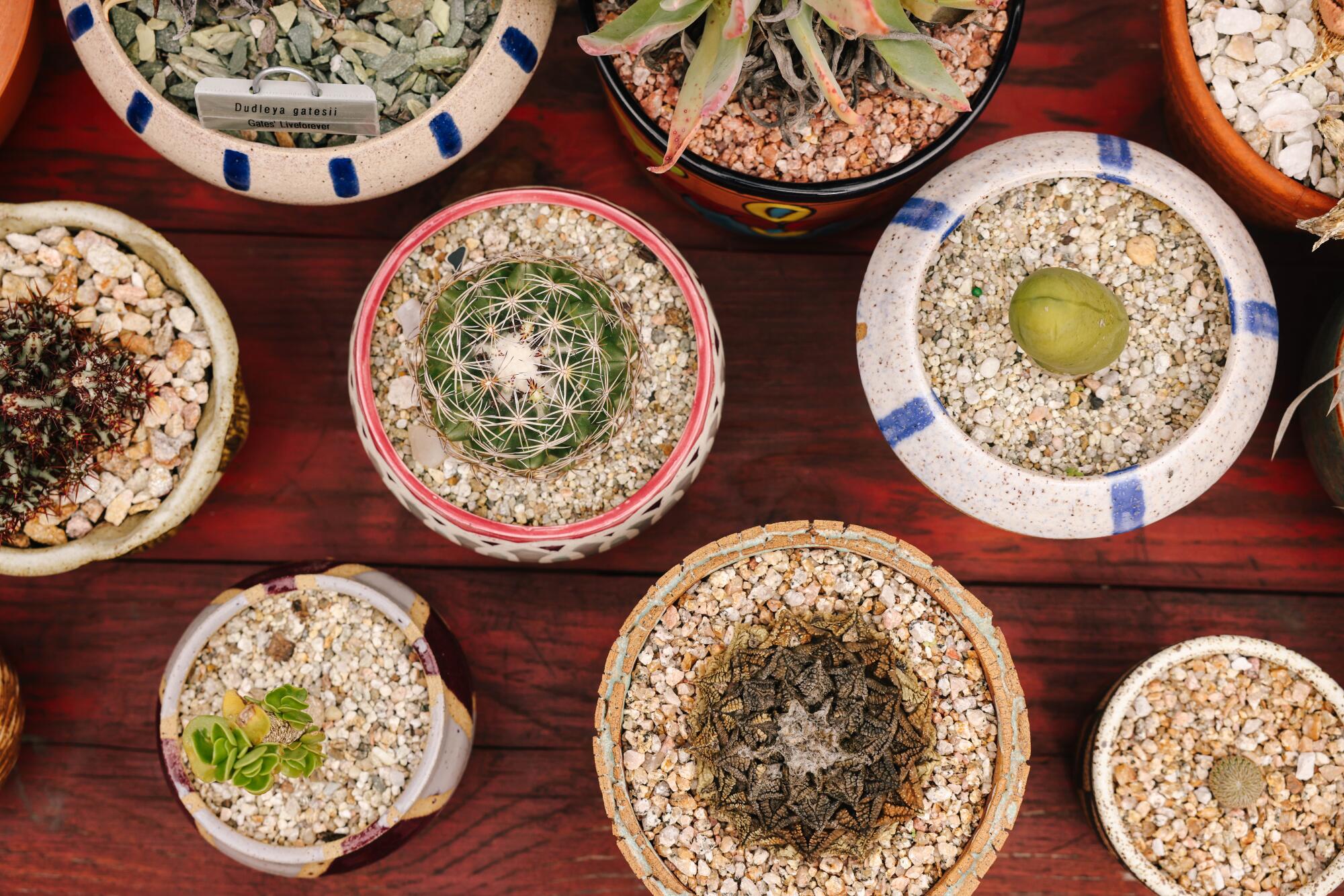
Another helpful resource has been regular visits to the California Botanic Garden in Claremont, the state’s largest botanic garden devoted entirely to native plants. “It’s a peaceful place and very inspiring to see plants in their habitat,” Zamora said. “We went there lots during the pandemic because it was such a great place to walk around.”
They’re also regular customers of Hardy Californians, a pop-up native plant nursery in Sierra Madre. Rojas, an entertainment publicist, even volunteered there during the Hollywood actors’ strike in 2023, and came away an even bigger convert to the versatility and beauty of native plants.
Their DIY garden tips
“Our neighbors have been very positive,” Rojas said. “We got little signs for all the plants because people on neighborhood walks always ask us what we’ve planted, and what we recommend for a specific situation.”
A large ficus tree in the parkway outside their front door has died, probably because of damage when the street was dug up for water-pipe repairs. It’s a city-owned tree, Zamora said, so a city crew will have to remove it, “but we’re definitely going to talk to them about replacing it with something native.”
Over the years, they’ve gotten much more sanguine about the circle of life in their garden. “We’ve learned that gardening is a process and some plants do better than others,” Rojas said. “We used to get so upset — ‘OMG, this died!’ — but at this point, it’s more like, ‘Oh, this didn’t like that location.’ Now we see it as just a new planting opportunity.”
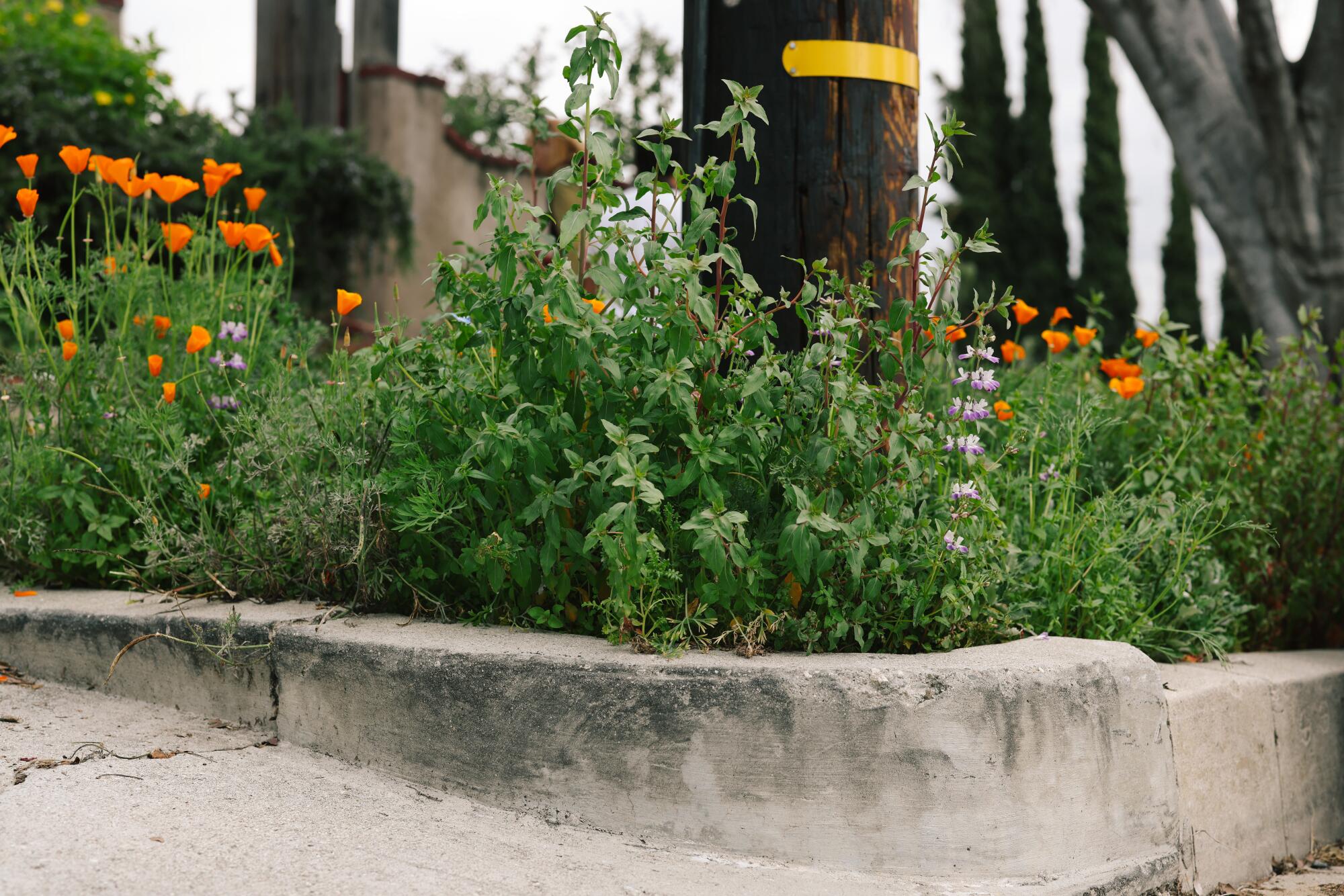
(Nemophila menziesii) and other wildflowers grow thickly in the narrow parkway outside their home.
More to Read
Sign up for The Wild
We’ll help you find the best places to hike, bike and run, as well as the perfect silent spots for meditation and yoga.
You may occasionally receive promotional content from the Los Angeles Times.
